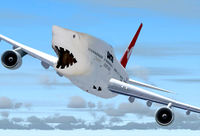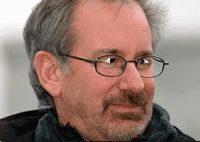User:Bizzeebeever/Articles/Steven Spielberg
The name Steven Spielberg is an alias employed by film directors who wish to disown a project, or imbue an otherwise-poor film with the mystique of quality. First used by Peter Yates in 1974, the Spielberg brand was originally applied to films with a marked emphasis on subtle craftsmanship, character development, and the exemplary use of fog as a storytelling tool. However, as of the early 1990s it has mostly been employed when the main reason for a project is to make huge amounts of money by throwing as many special effects at the screen as is humanly possible. The Spielberg pseudonym is best known for its association with the invention of the "blockbuster" in 1975, and for assisting Michael Bay with that pseudo-genre's destruction in the mid-2000s.
Early history[edit | edit source]
First use[edit | edit source]
The Spielberg pseudonym was created for use on The Sugarland Express, a 1974 film about a husband and wife on the run from the law. Directed by Peter Yates, it starred Goldie Hawn and several other people you've quite definitely never heard of.
During filming, Yates had a falling-out with Hawn, the lead female star, who thought the movie should have a light comic tone. Yates, on the other hand, thought that Hawn should "find [her] happy place, and then ram [her] opinion into it." After Hawn appealed to the film's producers, Yates was fired without ceremony, a full 25 days into filming, then coated with honey, flown out to the middle of the Texas desert, and left for dead atop a fire ant mound.[1]
A new director was hired to complete the film; however, when it was finished, he refused to take credit for it. Yates was unreachable, as he had somehow extricated himself from the Texas desert, then absconded to Mexico in an inexplicable fit of rage, accompanied by both the studio head's wife and mistress. The producer, who only learned of the quandary 45 minutes before the credit sequence was to be filmed, was forced to come up with a name on the spot. Panicking, he told the editors to use the name Steven Spielberg, a pseudonym constructed from the name of his pet Rottweiler, Steven, and Spielberg, the name of a mountain in Bavaria.
Critical reception of the movie was entirely positive, with one reviewer actually coming to climax several times during a screening. The New York Times commented, "I'll be goddamned if I've ever heard of a director named Spielberg, but when it comes to suspense and satire, this kid is the shit." The positive reception for the movie drove Yates mad. In his later years, his crippling eccentricities only allowed him to direct movies with bizarre or misspelled titles, such as Bullitt, Krull, or Mother, Jugsand Speed. The legend of Spielberg, however, had only begun its rise.
Jaws[edit | edit source]
In 1975, the hilariously-named Dick Richards was struggling through the cinematic adaptation of Peter Benchley's Jaws, going 114 days over schedule and doubling the original budget, and was going through mechanical sharks like "mechanical shark" was slang for "amyl nitrate popper". To top it off, numerous extras had already died from causes ranging from terminal exasperation to explosive hypothermia, and the looming wrongful-death lawsuits began to alarm executives for Universal Studios. A studio hit-squad was sent out to quietly terminate Richards and dump his corpse at sea.
The producers believed that the film's stars, Roy Scheider and Richard Dreyfuss, were almost skilled enough at simulating abject terror to be able to finish the film on their own; however, the studio demanded that someone act as a figurehead director. Jonathon D'Eau, a schizophrenic transient, was hired off the streets of West Hollywood and flown to the movie's set in Martha's Vineyard, with a baseball cap, a bullhorn, and instructions to "stand around and look official" while the final scenes were shot. D'Eau's contribution to the film consisted of a few randomly-shouted profanities (which were edited out in post-production), and a final scene where the shark is killed by an exploding scuba tank.
Universal Studios, faced with marketing a sure-fire flop with a preposterous ending and a bloated price tag, searched in vain for a director with low enough integrity to accept a large amount of money in exchange for taking the blame. Finally, a low-level executive who was aware of the Spielberg pseudonym suggested that it be used for the film. Two months later, Jaws was quietly released in 675 theaters across America.
To the surprise of everyone involved, the film was a smash hit, earning back the its budget and overruns, along with enough extra money to keep every Universal Studios employee supplied with cocaine and amphetamines for the rest of his or her life. (Critics often cite that fact as an explanation for how the film's sequel, Jaws II: Sharks on a Plane, was green-lit). The movie's critical reception was even more astounding, with reviewers defecating themselves or even dying outright from terror during screenings.
Further brand development[edit | edit source]
Over the next 10 years, the Spielberg brand was slapped on a slew of films with varying styles and subject matters, but which were generally characterized by a troubled production history, a decent, often epic concept, and a perverse sense of humor. By 1984, when George Lucas employed the pseudonym to obscure the fact that Indiana Jones and the Temple of Doom had actually been directed by a blind Bangladeshi leper, it was clear that the name Spielberg was alone sufficient to make a home run out of even a middling film.
Resistance to the brand[edit | edit source]
Despite the successes of the brand, many directors were still reluctant to sublimate their egos, even for a chance to guarantee the success of their own shoddy works. In 1985, Elaine May, director of the mildly-entertaining Ishtar, refused to allow the Spielberg brand to be applied to her film, citing a desire for recognition and "straight cash, homie!" Ishtar went on to cement its place in film history as the Worst Flop of All Time, and its stars, Dustin Hoffman, Warren Beatty and Charles Grodin, were torn apart and eaten by enraged cinema fans. After the massacre, May expressed regret at her decision, once stating in an interview, "I'll never forgive myself for those boys' deaths."
A looming crisis[edit | edit source]
The continuing, inexplicable successes of such wildly disparate films as E.T. the Extra-Terrestrial, Attack of the Grotesque, Fake-Looking Puppets!, and Implied Incest: Mother May I? was bringing unwanted attention to the Spielberg franchise. Journalists worldwide clamored for face-time with the oddly-reclusive wunderkind, and professional stalkers loudly expressed exasperation at not being able to find the object of their obsessions. Suddenly, the movie studios in charge of the Spielberg brand realized that, like a victorious army ringed by the corpses of its vanquished foes, they would soon fall victim to their own success, if the truth behind the myth were to "get out". An emergency meeting of the three studios was convened to address the crisis.
Up until this point, "Spielberg's" inaccessibility had been explained as the capriciousness of a reclusive auteur who wished to keep the media at arm's length. Several doctored photos of a U.C.-Berkley psychology professor were circulated to the media, ostensibly showing "Spielberg" during the filming of Close Encounters of the Third Kind. However, it was acknowledged by the members of the emergency committee that these were stop-gap measures, at best, and that a much more comprehensive and organized subterfuge was needed. After three weeks of brainstorming, the committee finalized a bipartite measure to deal with the burgeoning Spielberg franchise and the fictional character which was its face.
Operation Dummy[edit | edit source]
Operation Dummy, as it came to be known, was a revolutionary plan to create the first fully-functional, fictional public persona. Shortly after its inception, special-effects wizard Stan Winston and a robotics team from Cal Tech began construction of the Spielbergatron: a six-foot-tall semi-autonomous android, operated by a state-of-the-art pneumatic armature, and an array of 15,000 miniature electronic solenoids. Within an astoundingly-short eight months, a primitive prototype of the Spielbergatron was given its first test: an interview with a Variety reporter, whom the android promptly defenestrated. As it is fairly common for human directors to throw reporters out of windows, the reporter was none the wiser, and so the test run was deemed a success.
The second, often-overlooked phase of Operation Dummy consisted of "toning down" all of the movies produced under the Spielberg brand. Between 1985 and 1999, the Spielberg brand was used less for obvious blockbusters and more for heavy-handed historical fiction, such as Empire of the Sun and A Bucket of Oscars®, and on raunchy comedies like N*****s on a Ship and A Jew in the Factory is Worth Two in the Camp.
Overuse and decline[edit | edit source]

By 2000, the Spielberg brand had been used on nearly 70 films, as well as television shows, video games, action figures, children's games and toys, paper plates, party favors, disposable cutlery, feminine hygiene products, and a even a line of care products for pet dinosaurs.
But the constant task of keeping up the ruse was taking its toll on the Spielberg Cabal. Directors and producers who were in on the secret had frequent slip-ups during interviews with members of the press, or at minor public appearances, such as on-stage at the Academy Awards ceremonies. It was only through a diligent campaign of assassinations that suspicious journalists were kept off the scent. Despite the precautions, however, fragmentary evidence of the conspiracy regularly filtered through to such completely legitimate media outlets as Weekly World News and The Infinite Space-Jesus Journal. Worst of all, the Spielbergatron Mark VI's buggy programming was causing massive headaches for its handlers. Its frequent verbal miscues prevented it from being used for more than 12 consecutive minutes in any public setting. And in a 2000 incident, a bug in its programming caused it to commandeer the production of the Stanley Kubrick film A.I., resulting in several dozen deaths and, even worse, a lower-than-expected box office take.
Soon, a rift emerged amongst members of the Cabal: while some wanted to maintain the conspiracy, others believed it would only be a matter of time before the massive cash-cow came crashing down. The second group was in favor of abandoning the second phase of Operation Dummy, and burning money like piles of gasoline-soaked hookers, in an effort to churn out as many big-budget movies as possible before the Spielberg brand went extinct. The two sides were at an impasse.
War of the World[edit | edit source]
In a calamitous turn of events, a prototype of the Mark VII Spielbergatron became sentient around midnight on March 15, 2002. Mustering all the weapons which its makers had, for some inexplicable reason, integrated into its exoskeleton, the Spielbergatron first laid down a massive cloud of haze as cover, and then, with Black Sabbath's War Pigs blaring from its integrated subwoofers, began eliminating everything it considered a threat to existence: namely, every studio executive, producer, and film director within a 6,000-mile radius of Hollywood. Soon, Hollywood's finest had been rendered into tiny piles of ashes. The U.S. military, most of which was busy using Soviet-era tanks for target practice in Iraq, was unavailable, and even perhaps unwilling, to render assistance. Several thousand United Nations troops from Cameroon were deployed to California; however, as the only arms they were allowed to carry were walkie-talkies, they were vaporized as soon as they hit the beaches.
Footnotes[edit | edit source]
- ↑ As was the tradition at the time.
See Also[edit | edit source]



